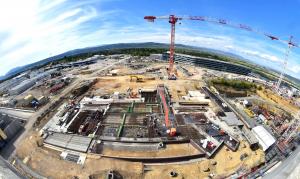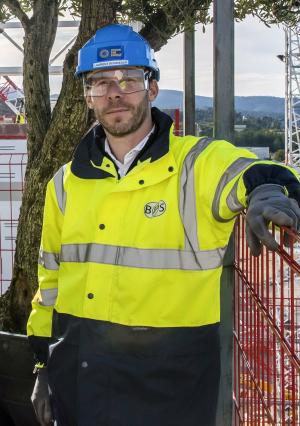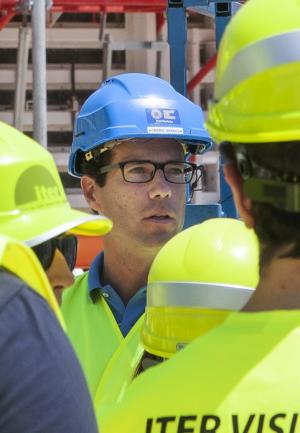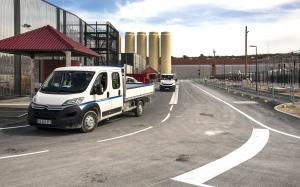« 85% des travaux de construction nécessaires pour le premier plasma sont terminés »
Dans le cadre des engagements pris pour le projet, l'Europe assure la construction de la quasi-totalité des bâtiments de la plateforme et des infrastructures du site, à savoir 39 bâtiments et zones techniques. Elle est chargée des travaux de génie civil des bâtiments, des travaux d'infrastructure du site (évacuation des eaux et galeries techniques), de la gestion de matériels tels que les grues, de la distribution électrique et des travaux d'adaptation du site, notamment les voies de circulation, la signalétique et l'éclairage. Le Complexe tokamak (qui regroupe les Bâtiments tokamak, diagnostics et tritium sur des fondations communes) est le projet à plus long terme à ce jour. Quatre années ont été nécessaires pour préparer les fondations de cette structure de 430 000 tonnes, qui est sortie de terre depuis.
La construction de l'installation scientifique ITER s'est poursuivie ces deux dernières années, malgré la crise du COVID-19. Rétrospectivement, quels ont été les principaux défis de cette période et comment la pandémie a-t-elle affecté la construction d'ITER ?
Les fondations du Complexe tokamak d'ITER ont été réalisées entre 2010 et 2014. Depuis, la structure est sortie de terre. Où en est aujourd'hui le Complexe tokamak et quand sera-t-il terminé ?
Le gros œuvre des Bâtiments tokamak et diagnostics est totalement terminé et le second œuvre est en voie d'achèvement. Les travaux de peinture sont finis à tous les étages et nous sommes en phase de retouche. Les portes sont installées et seuls quelques ajustements restent à effectuer. D'autres petits travaux de finition, tels que l'installation des plateformes métalliques, des plinthes en béton et des faux planchers, sont encore prévus, mais tout sera terminé d'ici l'été 2022. Il faut souligner que la construction du Bâtiment tritium, qui était à l'arrêt depuis 2017 afin de focaliser les travaux sur le Bâtiment tokamak, a repris en 2021. Nous espérons le terminer d'ici la mi-2024.
Les travaux de construction sont réalisés par lots. Pouvez-vous nous dire combien de lots de travaux sont terminés et combien sont en cours ou doivent encore être attribués ? En termes de pourcentage, quel est le degré d'avancement des travaux de construction des bâtiments et de l'infrastructure nécessaires pour le premier plasma ?
Neuf des 17 lots de travaux sont achevés et les huit autres sont en cours. 85% des travaux de construction nécessaires pour produire le premier plasma sont aujourd'hui terminés. Entamé début 2016, le contrat TB16, qui concerne les infrastructures du site (tranchées techniques, évacuation des eaux pluviales et travaux d'adaptation du site, notamment la voirie et l'éclairage), touche à sa fin. L'équipe a récemment franchi un nouveau cap avec l'achèvement de la voie de circulation définitive de la plateforme (voir la photo ci-dessous).
Depuis le début du chantier, l'équipe F4E bénéficie de l'aide du bureau d'études ENGAGE et de l'APAVE, l'entreprise responsable de la sécurité sur le site. Comment fonctionne cette collaboration et comment parvenez-vous à maintenir une bonne cohésion entre les différents éléments de l'équipe ?
Une bonne partie de l'infrastructure d'ITER n'est pas visible à l'œil nu, notamment les galeries techniques, les réseaux de distribution et les tunnels d'évacuation des eaux. Que pouvez-vous nous dire de ce « monde souterrain » qui est tout à fait essentiel au bon fonctionnement d'ITER ?
ITER est un peu comme un aéroport : la partie visible ne représente qu'une petite fraction des installations. Les réseaux souterrains sont gigantesques, avec plus de cinq kilomètres de galeries reliant entre eux les différents bâtiments ainsi que des centaines de kilomètres de réseaux de distribution d'électricité, d'eau et d'autres fluides. Ce fut un vrai défi de gérer la construction de toutes ces installations souterraines alors que d'autres sous-traitants bâtissaient simultanément d'énormes structures en surface. Notre capacité d'anticipation, ainsi que la coordination entre nos équipes et les sous-traitants, ont joué un rôle essentiel dans la réussite du projet.
Nous estimons que plus de 15 000 personnes ont contribué à la construction du site ITER. Près de 5 000 entreprises venues d'une dizaine de pays européens sont intervenues. À ce jour, nous n'avons déploré aucun accident grave et aucun blessé grave n'a été signalé sur le chantier. Les statistiques relatives au chantier (taux de fréquence des accidents du travail) sont quatre fois meilleures que les chiffres français, ce qui est une vraie réussite, même s'il est essentiel de s'améliorer en permanence dans le domaine de la sécurité. Nous nous efforçons de repérer les « quasi-accidents » afin d'améliorer nos procédures, d'en tirer des leçons et de renforcer notre niveau de sécurité.
Comment la présence du personnel et des sous-traitants de Fusion for Energy a-t-elle évolué au cours des 13 années de construction ? Combien de personnes compte l'équipe de Fusion for Energy qui gère les activités restantes et quelles sont vos prévisions pour les années à venir ?
Les activités de Fusion for Energy ont évolué au fil du temps et, alors que 85% des infrastructures requises pour le premier plasma sont terminées, nous n'en sommes qu'à 60% de l'ensemble des travaux. L'équipe BIPS reste stable (environ 80 personnes, dont la moitié relève de Fusion for Energy et l'autre moitié d'ITER Organization). Elle sera mobilisée au même niveau pour relever les défis à venir. Nous devons encore terminer les travaux de génie civil du Bâtiment tritium (avec trois niveaux supplémentaires à construire), finaliser un ensemble de bâtiments nécessaires pour sécuriser la distribution électrique et achever le Bâtiment de contrôle d'ITER, les réseaux de distribution dans les bâtiments auxiliaires ainsi que les passerelles techniques qui amèneront l'électricité et les fluides cryogéniques dans le Complexe tokamak. Autre prouesse à venir, la cellule chaude d'ITER, dont le volume et le niveau de complexité sont comparables à ceux du Complexe tokamak. Bien que nous soyons déjà à mi-chemin de ce long parcours, il nous faudra relever des défis encore plus immenses !





